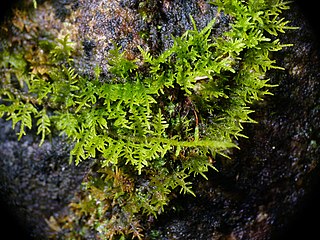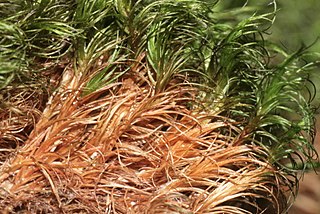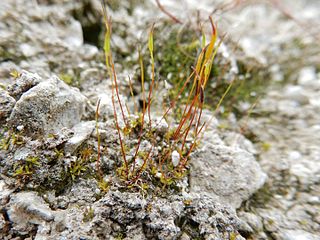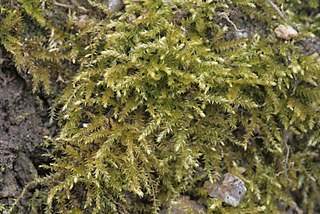
Funaria is a genus of approximately 210 species of moss. Funaria hygrometrica is the most common species. Funaria hygrometrica is called “cord moss” because of the twisted seta which is very hygroscopic and untwists when moist. The name is derived from the Latin word “funis”, meaning "a rope". In funaria root like structures called rhizoids are present.
Neckeropsis is a genus of plant in the family Neckeraceae.

Thamnobryum is a genus of moss in the family Neckeraceae. There are about 50 species. The genus is distributed throughout the world.

Hypnaceae is a large family of moss with broad worldwide occurrence in the class Bryopsida, subclass Bryidae and order Hypnales. Genera include Hypnum, Phyllodon, and Taxiphyllum.

Dicranaceae is a family of haplolepideous mosses (Dicranidae) in class Bryopsida. Species within this family are dioicous. Genera in this family include Dicranum, Dicranoloma, and Mitrobryum.

Neckeraceae is a moss family in the order Hypnales. There are about 200 species native to temperate and tropical regions. Most grow on rocks, or other plants.

Barbula is a genus of mosses in the family Pottiaceae.

Ditrichum is a genus of haplolepideous mosses (Dicranidae) in the family Ditrichaceae.

Thuidiaceae is a family of mosses within the order Hypnales. It includes many genera but the classification may need to be refined. The core genera are Thuidium, Thuidiopsis, Pelekium, Aequatoriella, Abietinella, Rauiella, Haplocladium and Actinothuidium form a clade but others currently placed in the family may belong elsewhere.

Campylopus is a genus of 180 species of haplolepideous mosses (Dicranidae) in the family Leucobryaceae. The name comes from the Greek campylos, meaning curved, and pous, meaning foot, referring to the setae which curve downwards.

Taxiphyllum is a genus of mosses in the family Hypnaceae.

Thuidium is a genus of moss in the family Thuidiaceae. The name comes from the genus Thuja and the Latin suffix -idium, meaning diminutive. This is due to its resemblance to small cedar trees.

Leucobryum is a genus of haplolepideous mosses (Dicranidae) in the family Leucobryaceae. The name comes from the Greek leukos, meaning white, and bryon, meaning moss.

Aloina is a genus of mosses belonging to the family Pottiaceae first described by Nils Conrad Kindberg. It has a cosmopolitan distribution.

Homomallium is a genus of moss belonging to the family Hypnaceae.

Neckera is a large genus of mosses belonging to the family Neckeraceae. The genus was first described by Johann Hedwig. The genus has a cosmopolitan distribution.

Plagiothecium is a genus of moss belonging to the family Plagiotheciaceae. It has a cosmopolitan distribution.

Homalothecium is a genus of mosses belonging to the family Brachytheciaceae.

Oxyrrhynchium is a genus of mosses belonging to the family Brachytheciaceae. The genus has a cosmopolitan distribution.


















